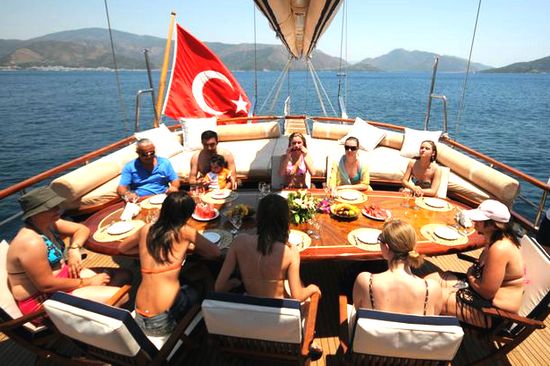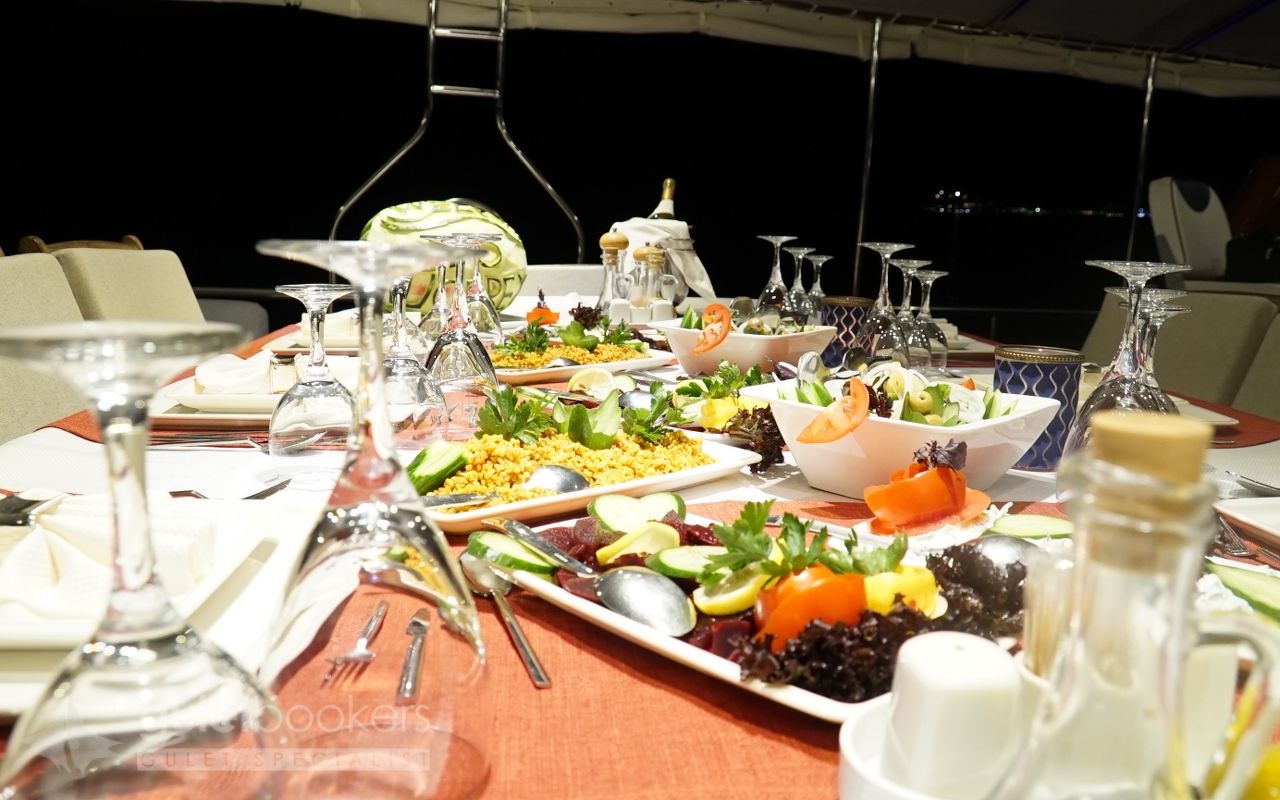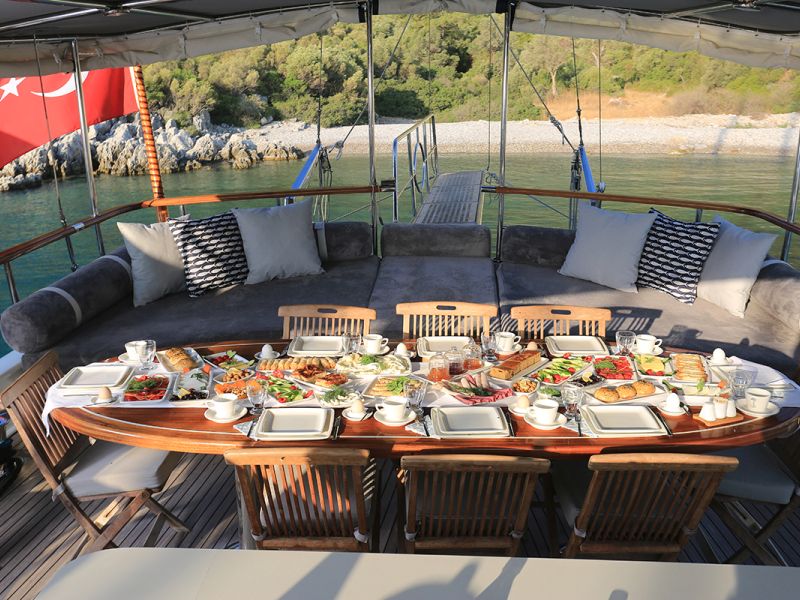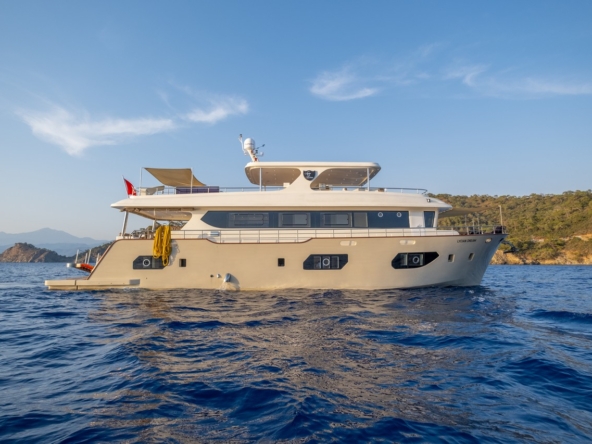Provisioning for a Blue Cruise
Complete Guide & 7-Day Menu + Shopping List
In this guide, you will find planning tips, storage techniques, daily menu suggestions, practical recipes, and a detailed 7-day shopping list you can use for your blue cruise.
Why Proper Provisions Matter
Provisioning on a blue cruise is more than just packing food; it ensures comfort, health, budget management, and convenience. Supplies may be limited at sea, so careful planning guarantees meals are tasty and safe. The boat’s conditions — limited freezer/fridge space, small kitchen, and sea motion — must also be considered. Provisioning is not just making a shopping list; it is about planning the entire kitchen operation.

1. Provision Planning: What to Know Before You Start
1.1 How Many Days and People?
The first step is to know the number of days and participants. Age groups (children, adults, seniors) and special diets (vegan, vegetarian, gluten-free, lactose-free, allergies) directly affect the menu. Example: For an 8-person crew, breakfast portions, lunch-dinner, and snacks should be calculated accordingly.
1.2 Check the Boat’s Kitchen Facilities
Stove count, oven presence, fridge/freezer capacity, water tank volume, storage space, and quality of equipment all influence menu planning. If your boat doesn’t have an oven, remove oven-based recipes or plan alternatives for grill or covered pan cooking.
1.3 Food Preferences & Allergies
If allergies (nuts, seafood, etc.) or intolerances exist, alternative menus must be prepared. For seasick-prone people, plan lighter meals rather than heavy, greasy dishes.
Tip: At the booking stage, confirm with the boat owner/crew about kitchen equipment, water/ice availability, and food storage capacity. The Platinyatcilik — Preparing for a Blue Cruise page provides useful details.
2. Essential Food & Ingredients — What to Buy
The following categories are essential for a boat kitchen. Practical notes on why each item is needed and how to store them are included.
2.1 Dry Foods & Basic Carbs
- Pasta: Quick, long-lasting, and suitable for many people. Buy several packs of different types (spaghetti, penne, fusilli).
- Rice / Bulgur: Necessary for pilaf dishes; long shelf life.
- Flour: Needed for pastries, crepes, flatbreads, or meatballs.
- Legumes (lentils, chickpeas, beans): Can be canned or dry. Canned are more practical.
2.2 Canned & Vacuum-Packed Items
Canned foods are lifesavers at sea: tuna, diced tomatoes, corn, beans, fish, etc. Vacuum-packed and long-life cheeses are also good options.
2.3 Breakfast Items
- Cheeses (white cheese, kaşar, lor) — choose long-lasting varieties.
- Olives, jam, honey, tahini-molasses.
- Eggs — store properly in the fridge; prefer fresh eggs over pre-boiled for longer trips.
- Bread: Buy daily; for longer storage, use flatbread/lavash/crackers.
2.4 Fresh Vegetables & Fruits
Basic vegetables: tomatoes, cucumber, peppers, onions, garlic. Fruits: oranges, apples, bananas (avoid overripe), pears, tangerines, seasonal strawberries/watermelon. Store fresh items in a cool, shaded, ventilated area.
2.5 Meat, Chicken & Seafood
Fresh meat and chicken for daily use should be properly packed and stored in the freezer. Fish can be kept fresh if caught, following storage rules. Frozen seafood (shrimp, calamari) is practical.
2.6 Oils, Sauces & Spices
Olive oil, sunflower oil, butter/margarine; salt, black pepper, red pepper flakes, oregano, cumin, mint, dried onion/garlic powders; ketchup, mayonnaise, mustard, soy sauce.
2.7 Snacks & Sweets
Nuts, dried fruits, biscuits, chocolate, energy bars, ice cream (if freezer available), and easy desserts.
Practical Tip: Keep canned and dry foods in an easily accessible spot. Opening the fridge frequently increases ice/water consumption — pre-portion cold foods for efficiency.

3. Storage & Preservation: Food Safety on Board
To prevent spoilage at sea, follow proper storage techniques:
3.1 Fridge / Freezer Management
- Freezer: Prioritize frozen meat, seafood, and ready-made frozen meals due to limited capacity.
- Fridge: Maintain temperature below 4°C and check regularly.
- Packaging: Store meat and fish in airtight packages; use leak-proof containers.
3.2 Vegetables & Fruits Storage
Hard fruits (apples, pears) last longer. Wrap leafy greens in damp paper towels and refrigerate. Keep bananas separate to avoid early ripening.
3.3 Canned & Dry Foods
Store cans in cool, dry places. Keep dry legumes and pasta in airtight containers to prevent pests.
3.4 Waste & Hygiene
Store waste according to boat rules; some bays have collection points. Maintain kitchen hygiene: separate cutting boards for raw and cooked foods, wash hands frequently, cook at proper temperatures.
4. Sample 7-Day Menu for a Blue Cruise
This sample menu is designed for 7 days, 8 people, assuming breakfast, lunch, and dinner, plus snacks:
- Day 1: Breakfast — eggs, cheese, olives; Lunch — pasta with tuna; Dinner — grilled fish, salad
- Day 2: Breakfast — pastries, fruit; Lunch — chicken pilaf; Dinner — meatballs, bulgur
- Day 3: Breakfast — bread, jam, cheese; Lunch — vegetable stew; Dinner — grilled shrimp, salad
- Day 4: Breakfast — omelet with vegetables; Lunch — lentil soup; Dinner — baked chicken, roasted vegetables
- Day 5: Breakfast — fruits, yogurt, nuts; Lunch — pasta with tomato sauce; Dinner — grilled meat, salad
- Day 6: Breakfast — eggs, olives, bread; Lunch — fish stew; Dinner — kebabs, rice
- Day 7: Breakfast — pastries, cheese, fruit; Lunch — vegetable casserole; Dinner — farewell grilled fish, salad
5. Shopping List for 7 Days
Based on the 7-day menu, here is a detailed shopping list for 8 people:
- Fresh vegetables & fruits: tomatoes, cucumber, peppers, onions, garlic, apples, oranges, bananas, pears
- Meat & seafood: chicken (approx. 4 kg), fresh fish (various, 4–5 kg), minced meat (2 kg), shrimp/calamaris (1 kg)
- Dairy: cheeses, yogurt, butter, eggs (3 dozen)
- Dry foods & grains: pasta (2–3 packs), rice/bulgur (2 kg), flour (1 kg), legumes (1–2 kg)
- Oils, sauces & spices: olive oil, sunflower oil, salt, black/red pepper, oregano, cumin, mustard, ketchup
- Snacks & desserts: nuts, dried fruits, biscuits, chocolate, energy bars
- Bread: daily purchase, or flatbread/lavash for storage
- Canned: tuna, beans, corn, tomato paste

6. Practical Tips & Tricks
- Prepare some meals partially in advance (chopped vegetables, marinated meat).
- Use labeled boxes and containers for easy access.
- Store food in layers, with frequently used items on top.
- Freeze water bottles to act as ice packs in the fridge.
- Plan for occasional meals in local restaurants to reduce provisioning pressure.
7.Proper provisioning is crucial for a successful and enjoyable blue cruise. Planning, smart shopping, and efficient storage make your sea adventure safe, stress-free, and delicious. Following this guide ensures that your crew can enjoy tasty, varied meals without worrying about shortages or spoilage.



